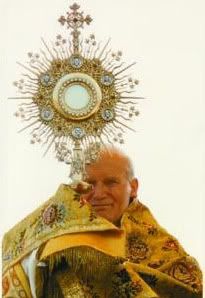Sacred Vessels, Part 1: Ciborium

I've been wanting to do a series, and I've decided to do the first one on sacred vessels. Everyone who went to a Catholic school learned the names of most of these in about 4th grade, but they aren't the sorts of things that tend to stick with you very well. Besides, we can all stand to learn a bit more about such things (I know I can -- this was not written off the top of my head).The ciborium is the vessel within which the species of the body of Our Lord in the Blessed Sacrament is stored (or "reserved") in the tabernacle in between masses. The word is of doubtful etymology, resembling both the Latin word for "food" and the Greek word for "cup." The rules governing its shape and construction are not so rigorous and universal now as they once were. Currently the General Instructions for the Roman Missal say:
Vessels should be made from materials that are solid and that in the particular region are regarded as noble. The conference of bishops will be the judge in this matter. But preference is to be given to materials that do not break easily or become unusable. ...Vessels made from metal should ordinarily be gilded on the inside if the metal is one that rusts; gilding is not necessary if the metal is more precious than gold and does not rust. ... The artist may fashion the sacred vessels in a shape that is in keeping with the culture of each region, provided each type of vessel is suited to the intended liturgical use.
The document issued rather recently by the Congregation for Divine Worship, Instruction Redemptionis Sacramentum, stipulates that sacred vessels should be made of materials that are "truly noble in the common estimation within a given region," and prohibits "common vessels, or others lacking in quality, or devoid of all artistic merit or which are mere containers, as also other vessels made from glass, earthenware, clay, or other materials that break easily."
Most ciboria seem still to conform to pre-concilar standards of shape: a round cup with a flat or bulged section on the bottom (to permit easier purification) mounted on a stem with a knob, and covered by a domed lid surmounted by a cross. Prior to Vatican II, the ciborium was veiled like the chalice, and when containing the Blessed Sacrament, could only be handled by sacred ministers. Also, prior to Vatican II, the ciborium was the only vessel out of which the priest dispensed Communion to the congregation.
History of the Ciborium
During the first three centuries of the Church, the Eucharist was not reserved, except occasionally in homes, because of the Roman persecution and the danger of desecration, and the term ciborium was used to refer to the canopy that was mounted over the altar in early churches. The practice of universally reserving the Blessed Sacrament in churches was adopted throughout the 5th and 6th centuries, but there was little conformity in either the method of reservation (regarding both the vessel and the placement within the church) or the name given to the instruments of reservation. Current methods of reservation in a tabernacle became standard throughtout the west beginning in the 16th century. Older styles of ciboria may still be seen in the Orthodox churches, which reserve their hosts in highly ornate boxes.
----------------
Sources
Chapter 5 of the General Instructions for the Roman Missal: "Arrangement And Furnishing Of Churches For The Eucharistic Celebration"
Congregation for Divine Worship and the Discipline of the Sacrament: Instruction Redemptionis Sacramentum On certain matters to be observed or to be avoided regarding the Most Holy Eucharist, section 117
Code of Canon Law, Chapter II
The Catholic Encyclopedia: "Ciborium"
File Under: Sacred_Vessels








1 Comments:
I think doing a series on sacred vessels is a brilliant idea. I could always learn more.
Very good blog. I have enjoyed reading it so far. Please visit mine if you can.
http://acatholiclife.blogspot.com
Post a Comment
<< Home